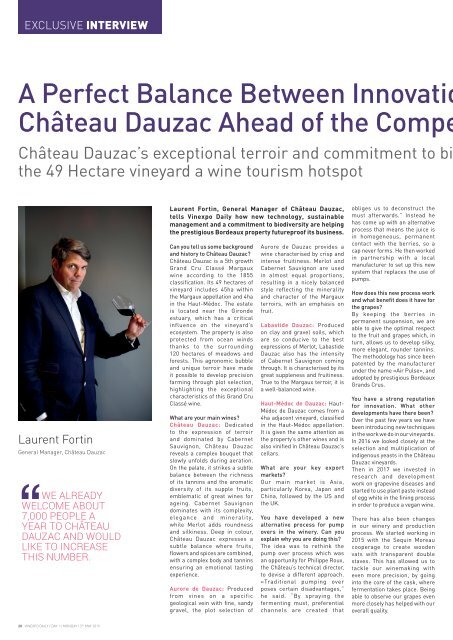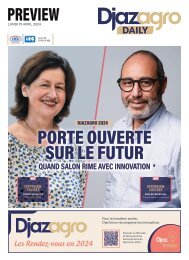Vinexpo Daily 2019 - Day 1 Edition
Create successful ePaper yourself
Turn your PDF publications into a flip-book with our unique Google optimized e-Paper software.
EXCLUSIVE INTERVIEW<br />
A Perfect Balance Between Innovatio<br />
Château Dauzac Ahead of the Compe<br />
Château Dauzac’s exceptional terroir and commitment to bi<br />
the 49 Hectare vineyard a wine tourism hotspot<br />
Laurent Fortin<br />
General Manager, Château Dauzac<br />
WE ALREADY<br />
WELCOME ABOUT<br />
7,000 PEOPLE A<br />
YEAR TO CHÂTEAU<br />
DAUZAC AND WOULD<br />
LIKE TO INCREASE<br />
THIS NUMBER.<br />
Laurent Fortin, General Manager of Château Dauzac,<br />
tells <strong>Vinexpo</strong> <strong>Daily</strong> how new technology, sustainable<br />
management and a commitment to biodiversity are helping<br />
the prestigious Bordeaux property futureproof its business.<br />
Can you tell us some background<br />
and history to Château Dauzac?<br />
Château Dauzac is a 5th growth<br />
Grand Cru Classé Margaux<br />
wine according to the 1855<br />
classification. Its 49 hectares of<br />
vineyard includes 45ha within<br />
the Margaux appellation and 4ha<br />
in the Haut-Médoc. The estate<br />
is located near the Gironde<br />
estuary, which has a critical<br />
influence on the vineyard’s<br />
ecosystem. The property is also<br />
protected from ocean winds<br />
thanks to the surrounding<br />
120 hectares of meadows and<br />
forests. This agronomic bubble<br />
and unique terroir have made<br />
it possible to develop precision<br />
farming through plot selection,<br />
highlighting the exceptional<br />
characteristics of this Grand Cru<br />
Classé wine.<br />
What are your main wines?<br />
Château Dauzac: Dedicated<br />
to the expression of terroir<br />
and dominated by Cabernet<br />
Sauvignon, Château Dauzac<br />
reveals a complex bouquet that<br />
slowly unfolds during aeration.<br />
On the palate, it strikes a subtle<br />
balance between the richness<br />
of its tannins and the aromatic<br />
diversity of its supple fruits,<br />
emblematic of great wines for<br />
ageing. Cabernet Sauvignon<br />
dominates with its complexity,<br />
elegance and minerality,<br />
while Merlot adds roundness<br />
and silkiness. Deep in colour,<br />
Château Dauzac expresses a<br />
subtle balance where fruits,<br />
flowers and spices are combined,<br />
with a complex body and tannins<br />
ensuring an emotional tasting<br />
experience.<br />
Aurore de Dauzac: Produced<br />
from vines on a specific<br />
geological vein with fine, sandy<br />
gravel, the plot selection of<br />
Aurore de Dauzac provides a<br />
wine characterised by crisp and<br />
intense fruitiness. Merlot and<br />
Cabernet Sauvignon are used<br />
in almost equal proportions,<br />
resulting in a nicely balanced<br />
style reflecting the minerality<br />
and character of the Margaux<br />
terroirs, with an emphasis on<br />
fruit.<br />
Labastide Dauzac: Produced<br />
on clay and gravel soils, which<br />
are so conducive to the best<br />
expressions of Merlot, Labastide<br />
Dauzac also has the intensity<br />
of Cabernet Sauvignon coming<br />
through. It is characterised by its<br />
great suppleness and fruitiness.<br />
True to the Margaux terroir, it is<br />
a well-balanced wine.<br />
Haut-Médoc de Dauzac: Haut-<br />
Médoc de Dauzac comes from a<br />
4ha adjacent vineyard, classified<br />
in the Haut-Médoc appellation.<br />
It is given the same attention as<br />
the property’s other wines and is<br />
also vinified in Château Dauzac’s<br />
cellars.<br />
What are your key export<br />
markets?<br />
Our main market is Asia,<br />
particularly Korea, Japan and<br />
China, followed by the US and<br />
the UK.<br />
You have developed a new<br />
alternative process for pump<br />
overs in the winery. Can you<br />
explain why you are doing this?<br />
The idea was to rethink the<br />
pump over process which was<br />
an opportunity for Philippe Roux,<br />
the Château’s technical director,<br />
to devise a different approach.<br />
«Traditional pumping over<br />
poses certain disadvantages,”<br />
he said. “By spraying the<br />
fermenting must, preferential<br />
channels are created that<br />
obliges us to deconstruct the<br />
must afterwards.” Instead he<br />
has come up with an alternative<br />
process that means the juice is<br />
in homogeneous, permanent<br />
contact with the berries, so a<br />
cap never forms. He then worked<br />
in partnership with a local<br />
manufacturer to set up this new<br />
system that replaces the use of<br />
pumps.<br />
How does this new process work<br />
and what benefit does it have for<br />
the grapes?<br />
By keeping the berries in<br />
permanent suspension, we are<br />
able to give the optimal respect<br />
to the fruit and grapes which, in<br />
turn, allows us to develop silky,<br />
more elegant, rounder tannins.<br />
The methodology has since been<br />
patented by the manufacturer<br />
under the name «Air Pulse», and<br />
adopted by prestigious Bordeaux<br />
Grands Crus.<br />
You have a strong reputation<br />
for innovation. What other<br />
developments have there been?<br />
Over the past few years we have<br />
been introducing new techniques<br />
in the work we do in our vineyards.<br />
In 2016 we looked closely at the<br />
selection and multiplication of<br />
indigenous yeasts in the Château<br />
Dauzac vineyards.<br />
Then in 2017 we invested in<br />
research and development<br />
work on grapevine diseases and<br />
started to use plant paste instead<br />
of egg white in the fining process<br />
in order to produce a vegan wine.<br />
There has also been changes<br />
in our winery and production<br />
process. We started working in<br />
2015 with the Sequin Moreau<br />
cooperage to create wooden<br />
vats with transparent double<br />
staves. This has allowed us to<br />
tackle our winemaking with<br />
even more precision, by going<br />
into the core of the cask, where<br />
fermentation takes place. Being<br />
able to observe our grapes even<br />
more closely has helped with our<br />
overall quality.<br />
20 VINEXPO DAILY / DAY 1 / MONDAY 13 TH MAY <strong>2019</strong>

















